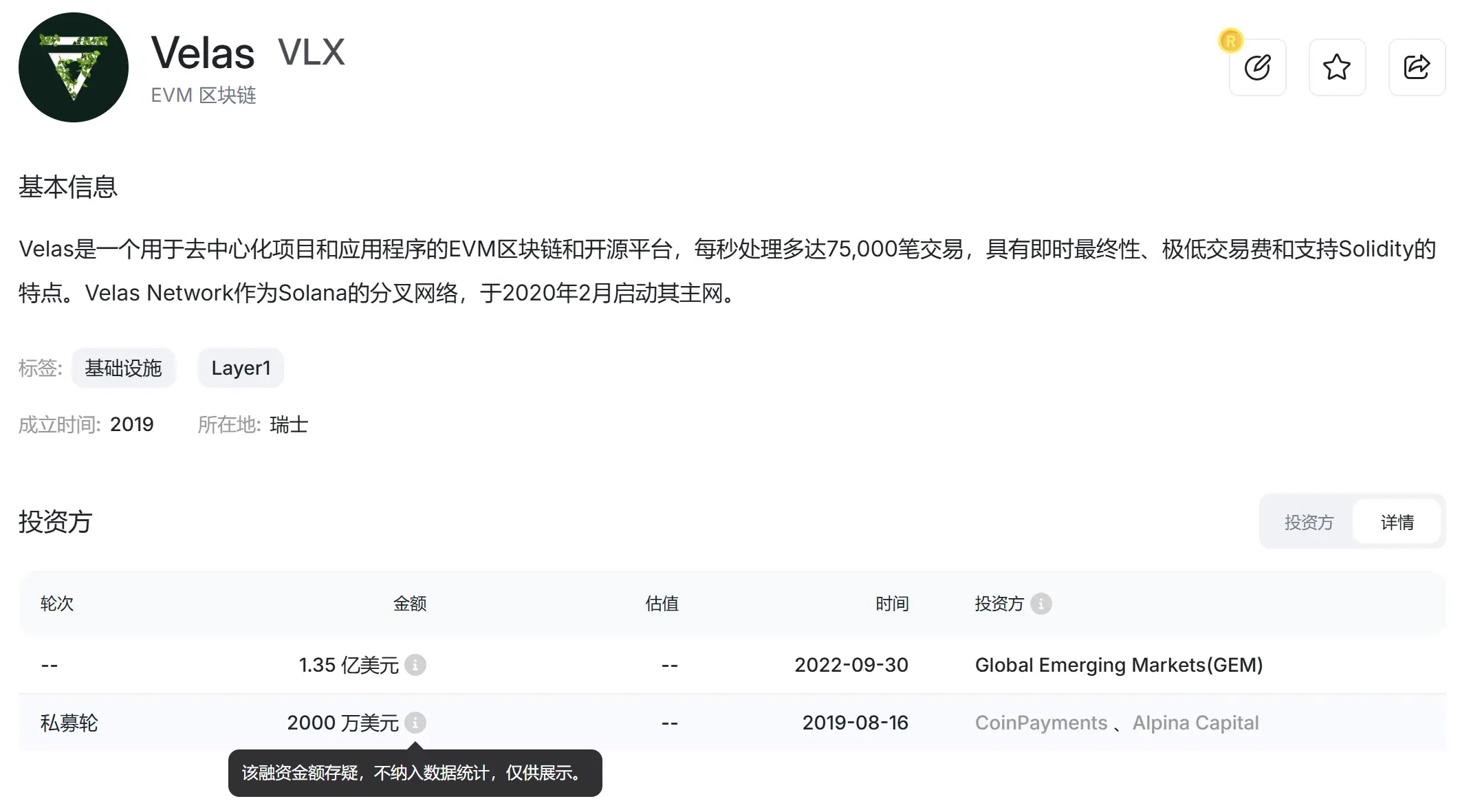Recently, the team has received a lot of feedback asking, how do you judge the authenticity of financing? What are your entry standards? Some users even criticized that we included a lot of false financing. This is indeed a very practical and embarrassing problem. As a data platform that everyone trusts, we must stick to the bottom line in terms of information credibility, but under the current market conditions, we have to face some contradictions in data comprehensiveness, timeliness and credibility.
According to the usual standards, we generally enter investment and financing information based on reports from trusted media such as Coindesk, The Block, Decrypt, Fortune, etc., and we will also refer to the financing information released by the project's official Twitter. This is also the common practice of all financing information platforms. The main difference lies in the comprehensiveness, timeliness and presentation method of financing inclusion.
In the past few cycles, the amount of financing has been one of the core indicators for most users to judge project quality. However, as long as quantitative data is involved, it will become the target of the project party's tricks without exception. In recent months, several projects have disclosed tens of millions of dollars in financing. For example, Wunder Social recently announced the completion of a $50 million financing, led by Rollman Management; Solix announced the completion of a $29.5 million financing, led by Eclip Foundation. Among them, Rollman Management has invested more than US$10 million in at least 10 projects in recent months.
Many KOLs are also taking advantage of the financing hotspots to recommend participation opportunities in these projects, and this is exactly the purpose of the project party: to use high financing to attract users' attention and build momentum for them. But if you look closely, there will be many suspicious points in these financings, such as the investors are very unknown, the project itself lacks highlights and the team background is average.
It can be determined that these financings are all falsely fabricated financing amounts by the project party and certain specific institutions. In response, the media has published several reports on this, such as《Behind the most "rich" crypto venture capital agency GEM Digital: a hidden and bizarre capital game》、《Digging deep into the capital game of Rollman Management: Hanging VC sheep heads, selling marketing dog meat》).对于此类情况的融资,我们会标注为存疑融资,其融资金额会出现一个提示符号,鼠标悬浮后会出现提示:该融资金额存疑,不纳入数据统计,仅供展示。

However, this entry may be because it is relatively hidden, and many users are still questioning that we are inclusion of fake financing, which is misleading. Some users are also asking, will we not conduct independent verification of financing? This is not that we don’t want to verify, but that there is no channel for verification at all. The project financing process is a black box. The project party and the investor have no obligation to disclose the specific transfer process and address. Even if we verify with the participants, as stakeholders, they will only affirm the project party’s statement.
What should I do? We can only further optimize the entry and product processes, add multiple new audit processes for suspicious financing events, and significantly prompt users. Therefore, in the recent product adjustment, we have hidden the amount of suspicious financing, and users will not see this financing on the investment and financing level channel. They can only see on the project details page that an institution has invested in the project and has a suspicious logo. In addition, users can see their financing news in the news module of the page.
For transparency, we will also regularly disclose the handling of this situation.

Just yesterday (23rd),Digital asset trading platform BitradeX announced on press release platform Finance Feeds to complete a £12 million Series A financing led by Bain Capital, and many Chinese media have also reported on this. Considering that Bain Capital is a very well-known VC organization, the news was not posted in trusted media and Twitter did not have any credible people’s attention, we did not enter this financing information.
In addition to making up financing directly, some more thrifty project parties will make a fuss about the financing form, such as adding the amount of "committed financing" or providing agreement liquidity (TVL) to the financing amount. What is Committed Financing? Let’s take a look at the 0G case. Last November, 0G announced a $290 million financing, but the article further mentioned that $250 million of theToken purchase and liquid capital commitment. The project CEO Michael Heinrich recently explained in an interview with Wu Shuo that this can be understood as a quota, but not a pre-agreed price, but a discount on the quota based on the open market after issuing the coin.
In other words, this promised investment did not actually occur, and the future amount is also very uncertain, but the project party's addition of such financing amounts to the official disclosed data can only indicate that the motivation is impure. For this case, it will not be recorded in the database.Only $40 million in seed rounds were recorded.
KernelDAO also exposed a black box operation in financing when clarifying the Web3port incident this month. Previously, KernelDAO announced that it had completed a $9 million financing, and Web3port was on its list of investors. However, due to Web3port's recent reputation bankruptcy, KernelDAO announced that Web3port has not actually invested in due to a variety of reasons and its SAFT has been cancelled. This shows that KernelDAO announced in advance that it had completed its financing before the investor actually invested. So is there any similar situation in other investors and other projects? We don't know.
In some cases, the project party will disclose the investors of old projects and old businesses and the new investors together in an attempt to confuse the public. This is the case with Balance, who was fiercely conquered these two days. Blockchain game platform Balance has repeatedly mentioned in PR that a16z is its investor, leading its $30 million financing, but further collecting information can be found that a16z is not investing in the Balance project itself, but the project's parent company E-PAL, and it was led by the investment in 2020 and 2021.
At that time, E-PAL was a game companion platform that focused on integrating social functions such as live broadcasts and voice chats, and had nothing to do with Web3. Now that the team has transformed into Web3, it is likely that the original Web2 business will be difficult to maintain. The company may map EPT tokens to E-PAL equity investor a16z, but this can no longer represent any recognition of a16z for the Balance project. Many users only buy Balance nodes by looking at the background of a16z investment, but now they are ruthlessly harvested by the project party, which fully demonstrates the critical importance of information quality and accuracy.
So in summary, how to better judge the reliability of Web3 project financing?
First, we can say with great confidence that after so many cases, we have re-examined and established new standards in the data entry process. Questionable data will be marked and verified independently. That is to say,Use it to filter most suspicious financing and effectively improve the efficiency of information search. If you find that there is an incorrect financing data, please feel free to feedback to us. If it is adopted, we can give you a reward of 20-100U each time.
second,Establish a basic understanding of the investment and financing market structure, such as what are the top VCs? With a financing amount of more than US$10 million, only the participation of the top VCs can be credible. The top VCs will not endorse ordinary small projects casually, and the financing of a large number of well-known VCs is generally very credible. If you are interested, you can further study which VC investment projects perform better in coin prices? Which VCs invest in projects are easier to go to large offices, etc.
Third, learn to use multi-dimensional data to comprehensively judge the credibility of the project, such as team background, media posting and Twitter followers. For example, the financing released by Bloomberg, Fortune and other media is extremely credible. If it is only published on press release platforms such as Chainwire and GlobeNewswire (the price is generally not higher than 1,000U), the credibility will be lower. The trend now is that many projects only raise funds on the X platform first and do not want to pay thousands of dollars in PR fees on other media platforms, which requires judgment on the quality of their X followers.
Nowadays, many Twitter plug-ins can help users view the fundamentals of a Twitter, and the website also provides such information. In fact, if a project claims to have obtained investment from a well-known VC on Twitter, the two parties will not interact with Twitter, and the project Twitter does not have the attention of trustworthy industry insiders, and such information will not be entered.
Of course, the most important thing is to learn to disenchant the amount of financing and VCs. When it was first born, most of the pages on the first screen of the homepage except for the search interface, provided financing round information. However, with the changes in the industry environment, VCs no longer play a key role in the development prospects of the project. Narrative and community are.Last year, Hyperliquid's VC-free and pure community-free model was proof of the fact that the top VC investment projects were poor and even shut down.
DYOR, going deep into the community and understanding the narrative thoroughly, is the ultimate key to cracking the financing black box and getting big results.
















No comments yet